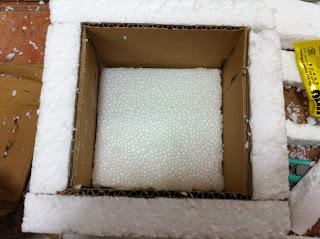 |
Sunday, 16 September 2012
Sunday, 9 September 2012
Thermal Energy Transfer
Thermal Energy Transfer
Singapore having a tropical climate, is naturally very warm. So what happens when we want to spend a day out with some of our favourite icy treats? In this experiment, we want to find out which material is best at keeping things cool.
There are 3 ways to transfer thermal energy (heat): Conduction, Convection and Radiation.
Conduction: The transfer of heat between substances that are in direct contact with each other.
Heat energy is conducted from the hot to the cold end of an object. Metals contain free electrons, and charged metal ions. The ions are packed closely together and they vibrate continuously. As one end of the metal heats up, kinetic energy of the vibrations increases. The free electrons move through the structure of the metal, colliding with ions as they go, transferring this kinetic energy from the hot parts to the cooler parts of the metal by the free electrons.
Thus, metals are good conductors of heat, while non-metals and gases are usually poor conductors of heat, or insulators.
Convection: The upward and downward movement of gases and liquids caused by heat transfer.
Heat energy is transferred from hot to cooler places by convection. It occurs when particles with a lot of heat energy in a liquid or gas move and take the place of particles with less heat energy. Particles take up more volume when heated. This is because the gap between particles widens, while the particles themselves stay the same size. Thus, they are less dense, and rise into the cold areas. The denser cold particles fall into warm areas, thus, convection currents that transfer heat from place to place are set up.
Radiation: The process of electromagnetic waves travelling through space.
All objects give out and take in thermal(or infrared) radiation. Some surfaces are better than others at reflecting and absorbing infrared radiation.
Dark and dull materials emit and absorb thermal radiation better than light and shiny ones, and a thin, flat object will radiate heat energy faster than a fat object.
Materials Chosen
1.
Cardboard: Is made of dense material (e.g dense wood fibers) that do not allow the quick transfer of energy. Thus, cardboard restricts the transfer of heat energy. It also has double walls for insulation because air is trapped between the walls, and retains its temperature for a long period of time, and thus can keep it hot or cold, providing insulation.
2. Styrofoam: Styrofoam has lots of tiny air bubbles inside of it. Air is an extremely poor conductor of heat because the molecules are spread out and slow down conduction. The heat can not flow efficiently through the material from outside to inside, since all of the air bubbles slow it down. Air does leak through, but does so very slowly, keeping things cool inside.
2. Styrofoam: Styrofoam has lots of tiny air bubbles inside of it. Air is an extremely poor conductor of heat because the molecules are spread out and slow down conduction. The heat can not flow efficiently through the material from outside to inside, since all of the air bubbles slow it down. Air does leak through, but does so very slowly, keeping things cool inside.
3.
Aluminum: Shiny surface for reflecting heat, and slows down the transfer of radiant heat.
4.
Newspaper: Good insulator. It will take heat longer to pass through the newspaper
Conclusion:
All the above materials of cardboard, Styrofoam and
aluminium and Newspaper are able to keep Ice kachang cold for a period of time,
as they are either good insulators or are able to reflect heat. Aluminium is
the least effective, as it is generally meant to keep foods warm. Styrofoam,
and cardboard are the most suitable as they can keep ice kachang cold for the
longest periods of time. They are also sturdy enough to be a box, as newspaper
and aluminium foil can be quite flimsy.
References:
http://www.bbc.co.uk/schools/gcsebitesize/science/aqa_pre_2011/energy/heatrev2.shtml
http://www.wisc-online.com/Objects/ViewObject.aspx?ID=sce30
http://www.wisc-online.com/Objects/ViewObject.aspx?ID=sce30
Subscribe to:
Comments (Atom)












